

歐盟經濟議題. Eu in slides en modefied 20210308. Gp eudor WEB NA0213714ENC 002. NA0118045ENN. European Union. An official website of the European UnionAn official EU websiteHow do you know?
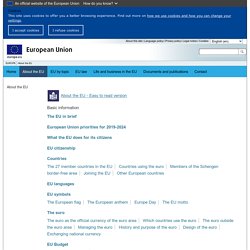
All official European Union website addresses are in the europa.eu domain. See all EU institutions and bodies Cookies This site uses cookies to offer you a better browsing experience. Find out more on how we use cookies and how you can change your settings. Skip to main content. Scribd. The common EU response to COVID-19. The EU is mobilising all resources available to help member states coordinate their national responses, and this includes providing objective information about the spread of the virus, the effective efforts to contain it and measures taken to repair the economic and social damage brought by the pandemic.

From this page, you can access the dedicated webpages and resources published by the EU institutions and bodies as well as EU member states. Recovery plan for Europe EU leaders successfully agreed on the recovery plan for Europe. A total of some €1.8 trillion will set Europe on path to a sustainable and resilient recovery. Re-open EU Plan your European travel and holidays, while staying healthy and safe, with this interactive tool available in 24 languages. European solidarity in action Countries, regions and citizens across the EU have been stretching out a helping hand to neighbours during these times of crisis. #EuropeansAgainstCovid19. 歐盟法之自主、統合性與會員國法之關係(II )Caratéristiques du droit de l’Union européenne:Autonomie et intégration dans les rapports des droits des Etats-Membres(II) - EUROPE - 台灣歐洲聯盟研究協會.
Dominique T.
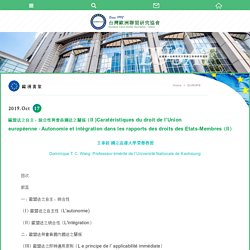
C. Wang Professeur émérite de l’Université Nationale de Kaohsiung 目次 前言 一、歐盟法之自主、統合性. European Union. 歐洲聯盟經濟議題109學年第二學期授課大綱. 歐盟經濟議題 課程說明. %E7%95%B6%E5%89%8D%E7%B6%93%E6%BF%9F%E6%83%85%E5%8B%A2%E7%B0%A1%E5%A0%B1. Coronavirus. Getty ImagesCopyright: Getty Images It is likely to be a slow process getting through the backlog of vehicles waiting to cross the Channel, according to John Keefe from Eurotunnel.
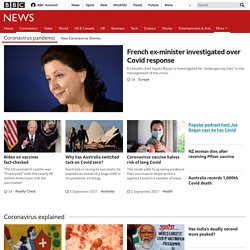
Speaking on BBC Radio 5 Live's Wake Up to Money programme earlier, he said: "If everyone arrived at the same moment, it would be difficult. We run six departures per hour, each one carries 32 trucks... somewhere between 180 and 200 trucks per hour. "From what we're seeing, there might be some form of testing, so if people have to go through testing first, then it looks like it might start as a trickle rather than a flood," he said. "Hopefully, it's just 48 hours and hopefully those trucks will eventually go through because the trucks have to get back to their base, the drivers have to get home. "The logistics and transport process is a circuit; it keeps on running in both directions.
歐洲知識小學堂.
歐盟加入晶片製程大戰 拚2030攻克2奈米. 英國公布脫歐貿易協議文本 全文長達1246頁. 從抗疫模範生到落伍者 德國怎麼了? 「英國一錯再錯 德國處處正確」——英國《電訊報》曾有這樣的標題;《新西蘭先驅報》曾將德國讚為新冠危機的贏家之一,稱其抗疫政策堪為全球表率;而以色列人有這樣的說法:梅克爾是新冠危機中「能讓人們明了局勢」的領軍人物。

這些讚譽為時不足一年,卻已好似來自一遙遠時代。 這還是德國嗎? 倘能在2020年夏時下注,看國際間誰能完美處理第二波或第三波疫情,相信很多人會把錢悉數押給德國。 還用說嗎,「德國製造」、組織方面的世界冠軍、擁有能以閃電般速度研發出新冠疫苗的科研幹才。 然而,這麼下賭的人,現在統統會破產。 原因就在於,德國已由新冠大流行中的一個受全球尊敬的奮鬥者變異為一個問題學生,在某些領域岌岌可危:口罩? 「這還是德國嗎?」 英國:德國失去了抗疫王冠 對德國疫苗接種起步慢的冷嘲熱諷多來自英國。 《金融時報》寫道:「德國失去了抗疫王冠,……德國在技術、工程和綜合能力方面曾以領先著稱,新冠疫苗接種工作眼下如此失敗,以致成了國恥,也就毫不足怪了。」 《倫敦時報》曾提及《圖片報》的一篇評論。 西班牙:德國優勢已然消失 西班牙人之驚訝可從馬德裡出版的 《國家報》的一個標題見出:「德國政府連連出錯,已經抹殺了關於德國有能力或有優越性的任何想法。」 西班牙亦遭受新冠重創,畢竟,該國死於新冠的人數幾乎與德國持平——超過7.1萬人,人口總數卻要少3600萬。
在法國和其它歐洲國家,媒體未過多關注德國及其失敗,而是批評歐盟的疫苗采購政策。 美國:憐憫取代了欽羨 在美國,足球場、汽車站、超市,甚至教堂裡都能注射疫苗,目前一天能接種近300萬劑疫苗;在新澤西州,只要診斷為「吸菸者 」就可以接種。 Why does activity recover faster after a crisis in the United States than in the euro zone. Why has COVID-19 hit different European Union economies so differently? All European Union countries are undergoing severe output losses as a consequence of COVID-19, but some have been hurt more than others.
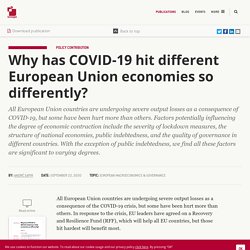
Factors potentially influencing the degree of economic contraction include the severity of lockdown measures, the structure of national economies, public indebtedness, and the quality of governance in different countries. With the exception of public indebtedness, we find all these factors are significant to varying degrees. All European Union countries are undergoing severe output losses as a consequence of the COVID-19 crisis, but some have been hurt more than others. In response to the crisis, EU leaders have agreed on a Recovery and Resilience Fund (RFF), which will help all EU countries, but those hit hardest will benefit most. This Policy Contribution explores why some countries have been hit economically more than others by COVID-19. The Role of Germany's Economy and Workplaces in the EU. Presentationslides11615312039269. Recovery plan for Europe. The largest stimulus package ever The EU’s long-term budget, coupled with NextGenerationEU, the temporary instrument designed to boost the recovery, will be the largest stimulus package ever financed through the EU budget.
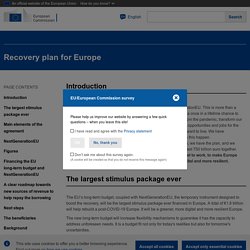
A total of €1.8 trillion will help rebuild a post-COVID-19 Europe. It will be a greener, more digital and more resilient Europe. The new long-term budget will increase flexibility mechanisms to guarantee it has the capacity to address unforeseen needs. It is a budget fit not only for today's realities but also for tomorrow's uncertainties.
Overview - COVID-19 - Eurostat. In this section, you can find a wide range of statistics and data published by Eurostat related to COVID-19.
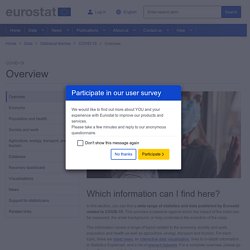
This can give you a baseline against which the impact of the crisis can be measured, provide the wider background or help you to see the evolution of the crisis. The information covers a range of topics related to the economy, society and work, population and health as well as agriculture, energy, transport and tourism. For each topic, we show our latest releases, an interactive data visualisation, links to more in-depth information in Statistics Explained and a list of relevant datasets. For a complete overview, please have a look at our European Statistical Recovery Dashboard.
News and current affairs from Germany and around the world. No going back: New imperatives for European banking. The imperative of our time COVID-19 remains an unresolved health challenge that has resulted in tragic loss of life.

The economic contraction emerging in its wake will likely be the deepest since World War II and the road to recovery will be long and challenging. Over the past few months, banking leaders have displayed resolve and resilience, moving swiftly to protect the health of employees and customers, ensure the continuity of basic banking services, and build up capital, liquidity, and cost buffers to strengthen their institutions. In the coming months, banks will start to return to something resembling normal service, reopening offices and branches. But so much has changed over the past few weeks: customers’ financial needs, the way they engage, how employees work, and even society’s expectations of banks.
ICT Innovation networking event defines practical steps towards internationalisation and visibility of ICT clusters in Eastern partner countries. On 14 December, an EU4Digital networking event discussed ways to organise and manage innovative clusters and cluster-like business networks in the area of ICT Innovation, focusing on establishing better visibility and connection of clusters in the EaP region.

The virtual networking event was targeted at cluster ecosystem organisations from Eastern partner countries, to facilitate their registration to the European Cluster Collaboration Platform (ECCP) and deepen knowledge of clusters’ organisation and development. Throughout the meeting, key EU organisations and ICT clusters from the EaP region presented value proposition, practical experience of cluster growth and international cooperation, as well as perspectives for the development of cluster ecosystems.
Participants included: Imf. How does the EU work? Home - Eurostat. EU Politics / Theories. EU Newsroom. Eu in slides en. Ec.europa. Brexit’s done, but anti-Brexit paper The New European is just getting started. The New European is another example of a news product created for a very specific story and moment. The weekly newspaper hit the streets just two weeks after the U.K.’s tumultuous Brexit vote in 2016.
With many Remainers stunned at the result — and angry at newspapers like the Daily Mail and The Sun who’d been cheerleaders for Brexit — The New European was meant to be a new and proudly pro-EU voice. It was also meant to be a temporary one; owner Archant only committed to printing four issues, extending its life week by week after that. But the paper was profitable by week three and seemed to have hit on a sustainable formula. Four and a half years later, Brexit is now officially in the past tense, but The New European aims to outlive it. This morning it was announced that Archant has sold The New European to its management and a new group of investors, with some big names attached. I am decidedly not a print optimist. First, it’d be weekly (or monthly!) A European Green Deal. Actions The European Green Deal provides an action plan to boost the efficient use of resources by moving to a clean, circular economy restore biodiversity and cut pollution.